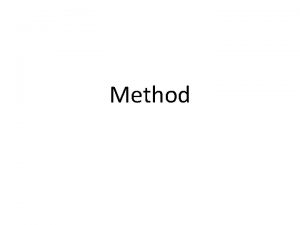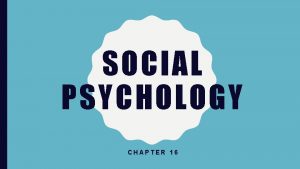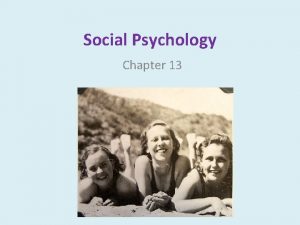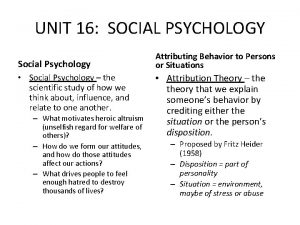Mini Research Paper an experimental report Social Psychology














- Slides: 14

Mini Research Paper: an experimental report Social Psychology

What is an experimental report? Experimental reports detail the results of experimental research projects. Experimental reports are write-ups of your results after you have conducted research with participants.

Scientific Method Like other sciences, psychology utilizes the scientific method and bases conclusions upon empirical evidence. When conducting an experiment, it is important to follow the five basic steps of the scientific method: 1. Ask a question that can be tested (hypothesis) 2. Design a study and collect data 3. Analyze results and reach conclusions 4. Share the results 5. Replicate the results

You should think of an experimental report as a "story" of your research in which you lead your readers through your experiment. As you are telling this story, you are crafting an argument about both the validity and reliability of your research, what your results mean, and how they fit into other previous work.

Order of Experimental Report � Abstract (optional for this report) � Introduction and literature review � Methods � Results and discussion � Bibliography in APA style

Introduction The introduction includes three parts: opening statements, literature review, and study overview. � Opening statements defines the problem broadly and gives background information on the psychological theory and then leads into the literature review. Your opening statements should set the stage for the story you are going to tell. � The literature review includes a historical overview and studies that are directly related to the problem at hand that logically lead to the hypotheses. � The study overview includes the hypotheses and briefly describes the method. The study overview functions as a transition to your methods section.

Methods: part I The method section includes three sub-sections: I. Participants: Discuss who was enrolled in your experiment. Include major demographics that have an impact on the results of the experiment (i. e. if race is a factor, you should provide a breakdown by race). The accepted term for describing a person who participates in research studies is a participant not a subject.

Methods: part II II. Apparatus and materials: The apparatus is any equipment used during data collection (such as computers, video recorders, or eye-tracking devices). Materials include scripts, surveys, or software used for data collection. It is sometimes necessary to provide specific examples of materials or prompts, depending on the nature of your study.

Methods: part III. Procedure: The procedure includes the step-by-step how of your experiment. A step-by-step listing in chronological order of what participants did during the experiment.

The results/discussion section is where you present the results of your research. Results � How do your results fit with the overall story you are telling? What results are the most compelling? You want to begin your discussion by reminding your readers once again what your hypotheses were and what your overall story is. The most important results should go first. � Provide information on your data analysis: Be sure to describe the analysis you did. Provide a clear narration of what the numbers mean. Results

Discussion � Begin by providing an interpretation of your results: what is it that you have learned from your research? � Do not repeat what you have already said in your results— instead, focus on adding new information and broadening the perspective of your results to you reader. � Consider also what new questions your study raises, what questions your study was not able to answer, and what avenues future research could take in this area.

Format � ~ 2000 words � 12 -point font � Double-spaced � 1” margins � Times New Roman or Arial � black ink

Sample Paper and Info �Here is a link to a sample research paper with notes: https: //owl. english. purdue. edu/media/pdf/2 0120820092738_670. pdf Source: https: //owl. english. purdue. edu/owl/resource/ 670/1/

Mini research ideas � How do people react when social norms are violated? This might involve acting in a way that is outside the norm in a particular situation, or enlisting friends to act out the behaviors while you observe. Some examples that you might try include wearing unusual clothing, applauding inappropriately at the end of a class lecture, cutting in line in front of other people, or some other mildly inappropriate behavior. Keep track of your own thoughts as you are performing the experiment and also observe how people around you respond. � Collect a wide variety of print advertisements and analyze how persuasion is used. What types of cognitive and affective techniques are utilized? Do certain types of advertisements tend to use specific kinds of persuasive techniques? � Analyze and apply a social psychology theory to a real life situation. Start by selecting a theory that you find particularly interesting. Spend some time assessing theory, then look for examples of theory at work in the world around you.
 Experimental vs non experimental research
Experimental vs non experimental research Mini research example
Mini research example Tahapan penelitian dalam psikologi
Tahapan penelitian dalam psikologi Research instrument in experimental research
Research instrument in experimental research Research instrument in experimental research
Research instrument in experimental research Experimental vs non experimental
Experimental vs non experimental What are the 5 types of non experimental research design
What are the 5 types of non experimental research design Experimental vs non experimental
Experimental vs non experimental Nonexperimental study
Nonexperimental study Estrategia da mini-mini ejemplo
Estrategia da mini-mini ejemplo Estrategia maxi maxi
Estrategia maxi maxi Fo maxi maxi
Fo maxi maxi Two factor theory psychology
Two factor theory psychology Fundamental attribution error ap psychology
Fundamental attribution error ap psychology Social psychology definition psychology
Social psychology definition psychology


























